#African Development Bank Group
Text
Tinubu, AU Mourn Malawi VP, Others Killed in Plane Crash
Tinubu, AU Mourn Malawi VP, Others Killed in Plane Crash
Tragedy Strikes Malawi as Vice President Saulos Chilima and Officials Die in Plane Crash
President Bola Tinubu extended his condolences to Malawian President Lazarus Chakwera and the people of Malawi over the tragic loss of Vice President Saulos Chilima and other officials in a plane crash on Monday. On Tuesday, President Chakwera announced that the wreckage of a plane carrying Malawi’s Vice…

View On WordPress
#African Development Bank Group#African Union#Akinwumi Adesina#condolences#Keywords: Tinubu#Lazarus Chakwera#Malawi#Moussa Mahamat#Nigeria#plane crash#tragedy#Vice President Saulos Chilima
0 notes
Text
PROVISION OF MAINTENANCE SERVICES FOR AIR CONDITIONING EQUIPMENT FOR THE RDGE 2024
AFRICAN DEVELOPMENT BANK GROUP TENDER AUGUST 2024
PROCUREMENT NOTICE
PROVISION OF MAINTENANCE SERVICES FOR AIR CONDITIONING EQUIPMENT FOR THE RDGE
ADB/RFP/RDGE/2024/0148
The African Development Bank (hereafter referred to as “The Bank”) wishes to invite technical and financial proposals from experienced companies for the provision of maintenance services for air conditioning equipment for the…
0 notes
Text
Rift Between Dangote and Regulators Continues To Worsen
Rift Between Dangote and Regulators Continues To Worsen
As Many May Lose Their Jobs
The Nigeria’s Economy has been thrown into tatters as rift between Dangote and the Regulators to continues worsen.
Reckoning that many businesses have folded and investors trooping out of the company, it is not a good time for the Economy to experience ongoing showdown with the Africa’s richest mam; this may…
#African Development Bank#Akinwunmi Adesina#Aliko Dangote#Dangote Group#Enabling Environment#Nigerai#Nigeria National Petroleum Company#NNPc#Peter Obi#Petroleum Product#President Of Angola#Total Removal Of Fuel Subsidy#Unemployment Rate
0 notes
Text
The Promise of a Demographic Dividend (CPD57 Side Event).
Africa's youth population offers immense potential, with three-quarters under 35, creating a demographic dividend. Despite challenges like gender inequality and high fertility rates, family planning policies have begun to shape a positive demographic transition. National Demographic Dividend Observatories (NODDs) in seven countries are driving progress, producing vital data and tools for policymaking.
At this high-level session, the focus will be on recognizing NODDs' contributions, addressing challenges, and advocating for renewed commitment to harnessing the demographic dividend.
Related Sites and Documents
Concept Note
Watch The Promise of a Demographic Dividend (CPD57 Side Event)!
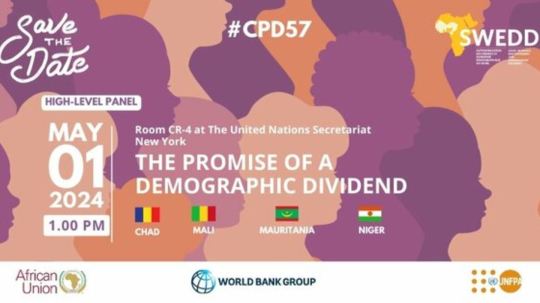
#Demographic transition#African youth#demographic dividend#population#cpd57#unfpa#commission on population and development#young people#side-events#african union#world bank group#demographics#icpd30#fertility rates#family planning policies#gender inequality
0 notes
Text
ADB $1 Billion Insurance Facility to Protect Millions of African Farmers
The African Development Bank Group has presented its planned $1 billion facility to provide insurance to more than 40 million farmers across the continent against the severe impacts of climate change.
The facility was widely praised by the World Food Programme (WFP), development agencies, insurance companies, and the private sector during a side event at COP28 in Dubai.
African Development Bank…
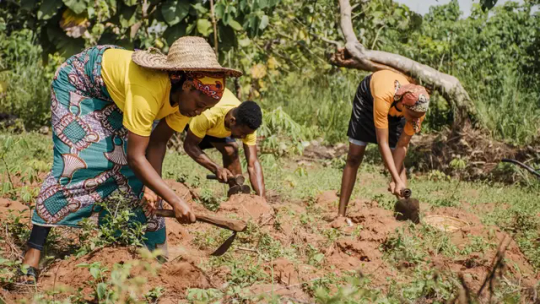
View On WordPress
0 notes
Text
Things Biden and the Democrats did, this week #19
May 17-24 2024
President Biden wiped out the student loan debt of 160,000 more Americans. This debt cancellation of 7.7 billion dollars brings the total student loan debt relieved by the Biden Administration to $167 billion. The Administration has canceled student loan debt for 4.75 million Americans so far. The 160,000 borrowers forgiven this week owned an average of $35,000 each and are now debt free. The Administration announced plans last month to bring debt forgiveness to 30 million Americans with student loans coming this fall.
The Department of Justice announced it is suing Ticketmaster for being a monopoly. DoJ is suing Ticketmaster and its parent company Live Nation for monopolistic practices. Ticketmaster controls 70% of the live show ticket market leading to skyrocketing prices, hidden fees and last minute cancellation. The Justice Department is seeking to break up Live Nation and help bring competition back into the market. This is one of a number of monopoly law suits brought by the Biden administration against Apple in March and Amazon in September 2023.
The EPA announced $225 million in new funding to improve drinking and wastewater for tribal communities. The money will go to tribes in the mainland US as well as Alaska Native Villages. It'll help with testing for forever chemicals, and replacing of lead pipes as well as sustainability projects.
The EPA announced $300 million in grants to clean up former industrial sites. Known as "Brownfield" sites these former industrial sites are to be cleaned and redeveloped into community assets. The money will fund 200 projects across 178 communities. One such project will transform a former oil station in Philadelphia’s Kingsessing neighborhood, currently polluted with lead and other toxins into a waterfront bike trail.
The Department of Agriculture announced a historic expansion of its program to feed low income kids over the summer holidays. Since the 1960s the SUN Meals have served in person meals at schools and community centers during the summer holidays to low income children. This Year the Biden administration is rolling out SUN Bucks, a $120 per child grocery benefit. This benefit has been rejected by many Republican governors but in the states that will take part 21 million kids will benefit. Last year the Biden administration introduced SUN Meals To-Go, offering pick-up and delivery options expanding SUN's reach into rural communities. These expansions are part of the Biden administration's plan to end hunger and reduce diet-related disease by 2030.
Vice-President Harris builds on her work in Africa to announce a plan to give 80% of Africa internet access by 2030, up from just 40% today. This push builds off efforts Harris has spearheaded since her trip to Africa in 2023, including $7 billion in climate adaptation, resilience, and mitigation, and $1 billion to empower women. The public-private partnership between the African Development Bank Group and Mastercard plans to bring internet access to 3 million farmers in Kenya, Tanzania, and Nigeria, before expanding to Uganda, Ethiopia, and Ghana, and then the rest of the continent, bring internet to 100 million people and businesses over the next 10 years. This is together with the work of Partnership for Digital Access in Africa which is hoping to bring internet access to 80% of Africans by 2030, up from 40% now, and just 30% of women on the continent. The Vice-President also announced $1 billion for the Women in the Digital Economy Fund to assure women in Africa have meaningful access to the internet and its economic opportunities.
The Senate approved Seth Aframe to be a Judge on the US Court of Appeals for the First Circuit, it also approved Krissa Lanham, and Angela Martinez to district Judgeships in Arizona, as well as Dena Coggins to a district court seat in California. Bring the total number of judges appointed by President Biden to 201. Biden's Judges have been historically diverse. 64% of them are women and 62% of them are people of color. President Biden has appointed more black women to federal judgeships, more Hispanic judges and more Asian American judges and more LGBT judges than any other President, including Obama's full 8 years in office. President Biden has also focused on backgrounds appointing a record breaking number of former public defenders to judgeships, as well as labor and civil rights lawyers.
#Thanks Biden#Joe Biden#kamala harris#student loans#student loan forgiveness#ticketmaster#Africa#free lunch#hunger#poverty#internet#judges#politics#us politics#american politics
2K notes
·
View notes
Photo

European Nations by Corruption Perceptions Index(2023)
by Specific_Ad_685
Note :- Corruption Perceptions Index is a report released annually by Transparency International for generally Public Sector and Public Institutions based corruption.
It measures corruption on a scale of 0 to 100 with 0 meaning highly corrupt(basically fully corrupt) and 100 meaning no corruption and fully clean.
The CPI is calculated using 13 different data sources from 12 different institutions that capture perceptions of corruption within the past two years.
13 data sources were used to construct the Corruption Perceptions Index (CPI)
2023:
1. African Development Bank Country Policy and Institutional Assessment 2021
2. Bertelsmann Stiftung Sustainable Governance Indicators 2022
3. Bertelsmann Stiftung Transformation Index 2024
4. Economist Intelligence Unit Country Risk Service 2023
5. Freedom House Nations in Transit 2023
6. Global Insight Country Risk Ratings 2022
7. IMD World Competitiveness Center World Competitiveness Yearbook Executive Opinion Survey 2023
8. Political and Economic Risk Consultancy Asian Intelligence 2023
9. The PRS Group International Country Risk Guide 2023
10. World Bank Country Policy and Institutional Assessment 2022
11. World Economic Forum Executive Opinion Survey 2023
12. World Justice Project Rule of Law Index Expert Survey 2023
13. Varieties of Democracy (V-Dem v. 13) 2023
115 notes
·
View notes
Text
"When the chief prosecutor of the international criminal court (ICC) announced he was seeking arrest warrants against Israeli and Hamas leaders, he issued a cryptic warning: “I insist that all attempts to impede, intimidate or improperly influence the officials of this court must cease immediately.”
...Now, an investigation by the Guardian and the Israeli-based magazines +972 and Local Call can reveal how Israel has run an almost decade-long secret “war” against the court. The country deployed its intelligence agencies to surveil, hack, pressure, smear and allegedly threaten senior ICC staff in an effort to derail the court’s inquiries.
Israeli intelligence captured the communications of numerous ICC officials, including Khan and his predecessor as prosecutor, Fatou Bensouda, intercepting phone calls, messages, emails and documents.
..
Since it was established in 2002, the ICC has served as a permanent court of last resort for the prosecution of individuals accused of some of the world’s worst atrocities. It has charged the former Sudanese president Omar al-Bashir, the late Libyan president Muammar Gaddafi and most recently, the Russian president, Vladimir Putin.
Khan’s decision to seek warrants against Netanyahu and his defence minister, Yoav Gallant, along with Hamas leaders implicated in the 7 October attack, marks the first time an ICC prosecutor has sought arrest warrants against the leader of a close western ally.
The allegations of war crimes and crimes against humanity that Khan has levelled against Netanyahu and Gallant all relate to Israel’s eight-month war in Gaza, which according to the territory’s health authority has killed more than 35,000 people.
...
Hacked emails and monitored calls
Five sources familiar with Israel’s intelligence activities said it routinely spied on the phone calls made by Bensouda and her staff with Palestinians. Blocked by Israel from accessing Gaza and the West Bank, including East Jerusalem, the ICC was forced to conduct much of its research by telephone, which made it more susceptible to surveillance.
Thanks to their comprehensive access to Palestinian telecoms infrastructure, the sources said, intelligence operatives could capture the calls without installing spyware on the ICC official’s devices.
“If Fatou Bensouda spoke to any person in the West Bank or Gaza, then that phone call would enter [intercept] systems,” one source said. Another said there was no hesitation internally over spying on the prosecutor, adding: “With Bensouda, she’s black and African, so who cares?”. ......
One of the sources said the Shin Bet even installed Pegasus spyware, developed by the private-sector NSO Group, on the phones of multiple Palestinian NGO employees, as well as two senior Palestinian Authority officials.
Keeping tabs on the Palestinian submissions to the ICC’s inquiry was viewed as part of the Shin Bet’s mandate, but some army officials were concerned that spying on a foreign civilian entity crossed a line, as it had little to do with military operations.
“It has nothing to do with Hamas, it has nothing to do with stability in the West Bank,” one military source said of the ICC surveillance. Another added: “We used our resources to spy on Fatou Bensouda – this isn’t something legitimate to do as military intelligence.”
...
Three sources briefed on Cohen’s activities said they understood the spy chief had tried to recruit Bensouda into complying with Israel’s demands during the period in which she was waiting for a ruling from the pre-trial chamber.
They said he became more threatening after he began to realise the prosecutor would not be persuaded to abandon the investigation. At one stage, Cohen is said to have made comments about Bensouda’s security and thinly veiled threats about the consequences for her career if she proceeded.
#palestine#free palestine#gaza#isreal#genocide#apartheid#american imperialism#us politics#police state#war crimes#icc arrest warrant#icc prosecutor
32 notes
·
View notes
Text
Happy International Women’s Day! Celebrating the impact of amazing women today, and every day. Here are just a few of the brilliant women we’ve been inspired by over the past 12 months. #IWD2024

After her daughter Brodie's death by suicide in 2020, Emma Webb launched a suicide prevention campaign. Brodie was a talented equestrian, which is what inspired @thewebstermwebb’s challenge pulling a life-size resin horse 160 miles from Chepstow to London.

Sarah Goldson has directed the @Wimbledon Ball Boy and Girl training since the 2012 Championships. The training helps develop life skills among young people, with 280 BBGs selected from local schools.

Vaitea Cowan is a co-founder of @Enapter, a company aiming to account for 10% of the world's green hydrogen by 2050. Enapter won the Fix Our Climate category at the 2021 Earthshot Prize and continues to thrive.

Bianca Sakol is the founder and CEO of @Sebbys_Corner, a shop-style baby bank which believes no child should go without the basic essentials they need to thrive. They provide a warm, welcoming environment and gives families choice and dignity to choose the items they need.

Mother and daughter, Jennifer and Emilia Clarke, were awarded MBEs for their brain injury charity work. They are co-founders of @SameYouOrg, a charity which develops better mental health recovery treatment for survivors and raises awareness around rehabilitation.

Dr. Gubby Ayida has been the CEO of @EvelinaLondon since May 2023 and oversaw its opening of the new Children’s Day Surgery Unit last year.

Wendy Simm was born and raised in Moss Side, Manchester and founded ‘Keeping It Real 24/7.’ The food bank focuses on delivering culturally important foods to those in need, such as yams and sweet potatoes, which generally are not provided by other food banks.

Captain Preet Chandi is a British Army Captain who holds three world records for polar trekking, most recently in December 2023 for becoming the world's fastest woman to complete a solo South Pole ski expedition.

Barbara Smith is a psychotherapist who has served over 16 years with @BritishRedCross, offering psychosocial support in disaster and war zones, aiding those in trauma.
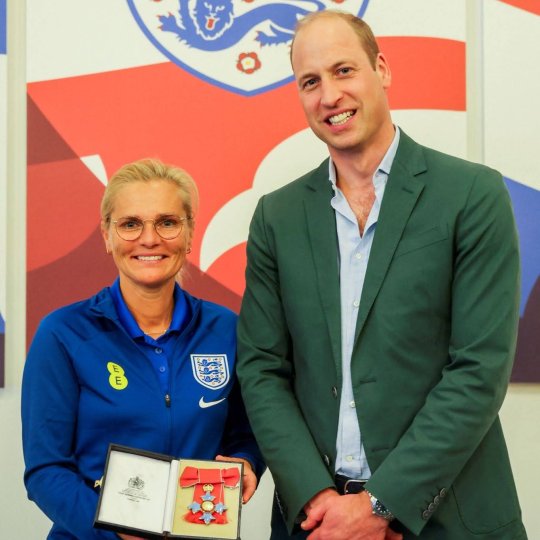
Sarina Weigman began her role as England Women’s Head Coach in September 2021, leading The @Lionesses to Euro 2022 victory. She was presented with an Honorary CBE in June last year.

Renee Salt is a Holocaust survivor who was born in Zdunska Wola, Poland in 1929. She survived both Auschwitz and Belsen, but her family did not. Renee has spoken to thousands of young people as part of @HolocaustUK's programmes.
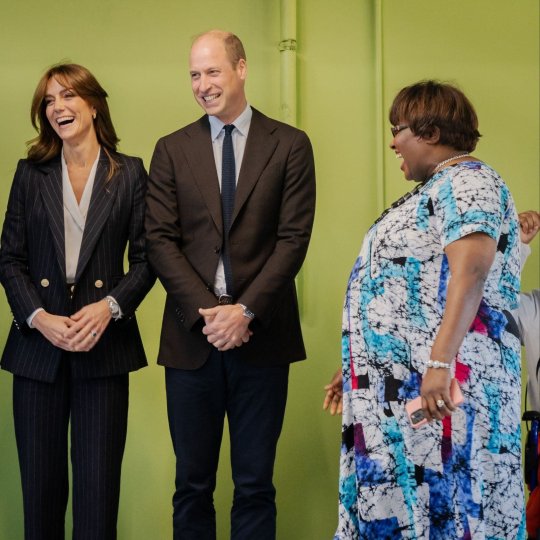
Professor Uzo Iwobi founded @rcccymru to boost art, heritage, and culture for minority groups in Wales. She empowers African Caribbean elders through learning initiatives and mentors young people to fulfil their aspirations.

In 2024, @hmsoardacious will be represented by Team Valkyrie, the first all-serving women's military team to row across the Atlantic. The @toughestrow challenge raises money for military charities and organisations that support veterans and their families.
- The Prince and Princess of Wales
#kensingtonroyal#international women's day 2024#prince of wales#princess of wales#kp twitter#kp tweets#8.03.2024#february24
32 notes
·
View notes
Text
We are Israel's largest human rights group [B’Tselem] – and we are calling this apartheid by Hagai El-Ad
One cannot live a single day in Israel-Palestine without the sense that this place is constantly being engineered to privilege one people, and one people only: the Jewish people. Yet half of those living between the Jordan River and the Mediterranean Sea are Palestinian. The chasm between these lived realities fills the air, bleeds, is everywhere on this land.
I am not simply referring to official statements spelling this out – and there are plenty, such as prime minister Benjamin Netanyahu’s assertion in 2019 that “Israel is not a state of all its citizens”, or the “nation state” basic law enshrining “the development of Jewish settlement as a national value”. What I am trying to get at is a deeper sense of people as desirable or undesirable, and an understanding about my country that I have been gradually exposed to since the day I was born in Haifa. Now, it is a realisation that can no longer be avoided.
Although there is demographic parity between the two peoples living here, life is managed so that only one half enjoy the vast majority of political power, land resources, rights, freedoms and protections. It is quite a feat to maintain such disfranchisement. Even more so, to successfully market it as a democracy (inside the “green line” – the 1949 armistice line), one to which a temporary occupation is attached. In fact, one government rules everyone and everything between the river and the sea, following the same organising principle everywhere under its control, working to advance and perpetuate the supremacy of one group of people – Jews – over another – Palestinians. This is apartheid.
There is not a single square inch in the territory Israel controls where a Palestinian and a Jew are equal. The only first-class people here are Jewish citizens such as myself, and we enjoy this status both inside the 1967 lines and beyond them, in the West Bank. Separated by the different personal statuses allotted to them, and by the many variations of inferiority Israel subjects them to, Palestinians living under Israel’s rule are united by all being unequal.
Unlike South African apartheid, the application of our version of it – apartheid 2.0, if you will – avoids certain kinds of ugliness. You won’t find “whites only” signs on benches. Here, “protecting the Jewish character” of a community – or of the state itself – is one of the thinly veiled euphemisms deployed to try to obscure the truth. Yet the essence is the same. That Israel’s definitions do not depend on skin colour make no material difference: it is the supremacist reality which is the heart of the matter – and which must be defeated.
Until the passage of the nation state law, the key lesson Israel seemed to have learned from how South Africa’s apartheid ended was to avoid too-explicit statements and laws. These can risk bringing about moral judgments – and eventually, heaven forbid, real consequences. Instead, the patient, quiet, and gradual accumulation of discriminatory practices tends to prevent repercussions from the international community, especially if one is willing to provide lip service to its norms and expectations.
This is how Jewish supremacy on both sides of the green line is accomplished and applied.
We demographically engineer the composition of the population by working to increase the number of Jews and limit the number of Palestinians. We allow for Jewish migration – with automatic citizenship – to anywhere Israel controls. For Palestinians, the opposite is true: they cannot acquire personal status anywhere Israel controls – even if their family is from here.
We engineer power through the allocation – or denial – of political rights. All Jewish citizens get to vote (and all Jews can become citizens), but less than a quarter of the Palestinians under Israel’s rule have citizenship and can thus vote. On 23 March, when Israelis go and vote for the fourth time in two years, it will not be a “celebration of democracy” – as elections are often referred to. Rather, it will be yet another day in which disfranchised Palestinians watch as their future is determined by others.
We engineer land control by expropriating huge swaths of Palestinian land, keeping it off-limits for their development – or using it to build Jewish towns, neighbourhoods, and settlements. Inside the green line, we have been doing this since the state was established in 1948. In East Jerusalem and the West Bank, we have been doing this since the occupation began in 1967. The result is that Palestinian communities – anywhere between the river and the sea – face a reality of demolitions, displacement, impoverishment and overcrowding, while the same land resources are allocated for new Jewish development.
And we engineer – or rather, restrict – Palestinians’ movement. The majority, who are neither citizens nor residents, depend on Israeli permits and checkpoints to travel in and between one area and another, as well as to travel internationally. For the two million in the Gaza Strip travel restrictions are the most severe – this is not just a Bantustan, as Israel has made it one of the largest open-air prisons on Earth.
Haifa, my birth city, was a binational reality of demographic parity until 1948. Of some 70,000 Palestinians living in Haifa before the Nakba, less than a 10th were left afterwards. Almost 73 years have passed since then, and now Israel-Palestine is a binational reality of demographic parity. I was born here. I want – I intend – to stay. But I want – I demand – to live in a very different future.
The past is one of traumas and injustices. In the present, yet more injustices are constantly reproduced. The future must be radically different – a rejection of supremacy, built on a commitment to justice and our shared humanity. Calling things by their proper name – apartheid – is not a moment of despair: rather, it is a moment of moral clarity, a step on a long walk inspired by hope. See the reality for what it is, name it without flinching – and help bring about the realisation of a just future.
#reaux speaks#resources#B’Tselem#israel#human rights#apartheid#south africa#palestine#the guardian#article#gaza#jewish#palestinian#anti zionism#zionism#free palestine
52 notes
·
View notes
Text
[VOA is US State Media]
A report by researchers from Johns Hopkins University is giving China better than expected marks for its performance in helping to restructure the crippling debt loads carried by some African countries.
The report is based on a detailed evaluation of Beijing's participation in the Debt Service Suspension Initiative, or DSSI, an international vehicle for developed nations to support struggling countries like Angola and Zambia.
The DSSI was introduced in 2020 at the start of the global pandemic by the International Monetary Fund and World Bank, which suggested the world’s 20 largest economies, known as the G-20, temporarily halt the collection of loans from the world’s poorest nations.
U.S. Treasury Secretary Janet Yellen and World Bank Chief David Malpass have recently accused China of being a barrier to debt relief, and U.S. Vice President Kamala Harris was in default-stricken Zambia last week urging the country's bilateral creditors — of which China is the biggest — to do more on restructuring Zambia’s debt.
But, despite some caveats, the report released this week by Deborah Brautigam and Yufan Huang from the China Africa Research Initiative found that overall, China “fulfilled its role fairly well as a responsible G-20 stakeholder.”
The analysts added that China “did implement the minimum steps of the DSSI fairly well, communicating with other players, and following through on pledges.”
According to the available data, Chinese creditors accounted for 30 percent of all claims and contributed 63 percent of debt service suspensions in the countries that participated in the DSSI.
“The metric by which you evaluate [China’s] performance depends on what your expectations were for the initiative,” Brautigam told VOA, noting that this was the first time the world’s second-largest economy had joined a multilateral initiative – a move one G-20 source called “miraculous.”
Brautigam said it was obvious that a new architecture is needed to deal with debt relief because the current system is dominated by the Paris Club, a group of wealthy Western nations that started lending to developing countries in 1956. In recent years, there have been more major new creditors, like China and bondholders.
“So what evolves out of this is really up in the air,” she said, adding that all lenders “need to be in together because otherwise you get all these suspicions, you know, worries about free riding.”
Successes and failures
The study concluded that China might have achieved more during the DSSI if not for fears that countries would simply take advantage of any debt relief to repay other creditors.
In Zambia, for example, Chinese creditors wanted assurances their relief wouldn’t be used to pay off the bondholders, while the bondholders were concerned that any relief from their side might go toward paying off China.
China was “totally justified” in its suspicions on this front, Brautigam said, because “in most countries, all of those creditors continued to be paid.”
“We need something that is simultaneous - you know, they all need to be in the room together … so that we don’t have this first-mover problem,” she added.
In Zambia, the Chinese decided against suspending their debt payments while the country was still paying bondholders, but this didn’t happen in Angola, China’s largest African borrower with around $20 billion in debt to Chinese entities. In that case, Chinese creditors provided 97% of the debt relief over the two-year period without asking for assurances that Angola wouldn’t continue making other repayments.
The researcher’s third African case study, Kenya, showed how China’s DSSI treatment was different from the other two. Chinese banks agreed to provide relief at first but later stopped loan disbursements and suspended only some 40 percent of the expected amount in 2021.
Moving forward
The study also showed how China's banks and central government, despite the country's top-down political structure, do not always act in unison. The fragmented nature of the Chinese system and bureaucratic hurdles often remain a barrier to debt relief.
Being part of the DSSI helped address that because it “pushed the Chinese government to align interests among fragmented banks and bureaucracies with conflicting goals. This process, still under way, is a necessary step toward full acceptance of the necessity for debt restructuring in the post-pandemic era,” the researchers found.
The DSSI ended in December 2021 and has been superseded by what’s known as the Common Framework to continue helping indebted countries like Zambia with their restructuring.
In January, World Bank chief Malpass said, “China is asking lots of questions in the creditors' committees, and that causes delays, that strings out the process.” Last month, Yellen accused Beijing of leaving developing countries “trapped in debt.”
China has called on the IMF and World Bank to also offer debt relief, with President Xi Jinping saying at the G-20 summit last year: “International financial institutions and commercial creditors, which are the main creditors of developing countries, should take part in the debt reduction and suspension for developing countries."
The Chinese Embassy in Zambia hit back at the U.S., calling Yellen’s “debt trap” comments “irresponsible and unreasonable.”
Ultimately, the study found, “the DSSI was a success in what some saw as its primary goal: to bring China into a multilateral, G20-supervised forum where Beijing has an equal voice.”
It now remains to be seen how the challenges highlighted by the pandemic relief program spill over into the current debt negotiations.
6 Apr 23
95 notes
·
View notes
Text
Senegal: Third drinking water treatment plant at Keur Momar Sarr, built with African Development Bank backing, substantially enhances water service in Dakar and surrounding area | African Development Bank Group

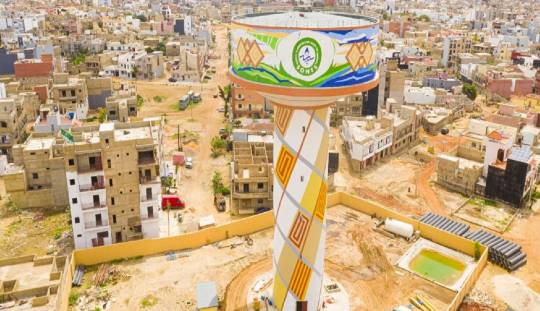
14 notes
·
View notes
Text
The spring meetings of the World Bank and International Monetary Fund have little of the drama of peace negotiations. They are often dominated by technical and technocratic questions concerning the intricacies of international finance. But for the poorest people in the world, the decisions made at these meetings are matters of life and death.
Since the 1990s, the World Bank has facilitated a dramatic decline in extreme poverty globally, from more than 1 in 3 people living in extreme poverty in 1990 to less than 1 in 10 today. But fragile and conflict-affected countries, such as the Democratic Republic of the Congo and Myanmar, have seen the opposite trend: In those places, extreme poverty is growing, and by 2030, they will be home to an estimated 59 percent of all people living in extreme poverty. The convergence of conflict, climate change, and economic shocks has left more than 300 million people dependent on humanitarian aid to survive.
This week’s meetings in Washington offer an opportunity for the World Bank to bridge this gap by revamping its approach to extreme poverty. This will require more imagination than we have historically seen from the development and humanitarian communities. But if the bank can break with traditional development frameworks and improve its reach, scale, and sustainability, it will be able to better support those who need it the most.
In stable states, development economics now has a playbook beyond the Washington Consensus, marked by free market principles and deregulation; international financial institutions now support sustainable and inclusive growth models. But in crisis-affected states, where effective humanitarian action is the first step on the road to development, the World Bank’s policy agenda is much less well developed.
The World Bank itself has recognized this. The bank’s new evolution road map, led by its president, Ajay Banga, recognizes the urgent need to focus on fragility, conflict, and climate change—among other global challenges—to achieve its mission to eradicate poverty on a livable planet. But it still needs a concrete plan.
Historically, the World Bank has relied on robust government partnerships. Yet as the landscape of poverty changes, it will need to adopt a more flexible approach. The bank should expand delivery of its services through nongovernmental partners, which can often better access communities in need. This is particularly important in crisis settings where a government may not be able to reach parts of the country.
For example, my organization, the International Rescue Committee (IRC), has successfully partnered with Gavi, the global organization that seeks to improve access to vaccines, alongside African-led civil society groups in Ethiopia, Somalia, South Sudan, and Sudan. As of February, our partnership has administered more than 1 million doses of lifesaving vaccines to children. Prior to the program, the IRC could access only 16 percent of targeted communities in the Horn of Africa. Now, we are able to reach 77 percent of those areas.
The World Bank also needs a plan to scale up its operations. This requires not just building up capacity but also reducing strains on national systems such as hospital networks, which are often stretched thin during a crisis. Humanitarian organizations such as the IRC have had success reducing acute malnutrition among children by partnering with community health workers to diagnose cases and administer treatment instead of adding to the caseload of hospitals.
It will be crucial for the bank to ensure that its programs can sustain any progress they make. This will require real, not rhetorical, localization: shifting power to local responders and building trust with them so that they can lead and deliver in aid efforts. One example of how localization can ensure that development efforts support a community’s long-term interests is the Building Resilient Communities in Somalia consortium. This program has collaborated with more than 450 communities over the past decade, and its work has been critical to avoiding famine.
Finally, the World Bank should launch a new model for its International Development Association (IDA), one of the largest sources of development finance for the world’s poorest countries. As the World Bank leadership and donors negotiate IDA replenishment this year, they should refine its finance mechanisms to be more responsive to countries’ risk, vulnerability, and accessibility to other sources of finance. For example, the IDA Crisis Response Window—which provides countries with additional resources to respond to climate, health, and economic shocks—could include better criteria to assess how fragility, conflict, and violence can compound these shocks.
More overall funding will be key to these efforts. In 2021, the last time the bank negotiated a financing package for the IDA, development partners agreed on a $93 billion package to support sustainable development in the world’s poorest countries. This year, donors should make even more ambitious pledging contributions that will put the IDA on track for tripling its size by 2030. Expanding nongovernmental partnerships will also help the bank improve disbursal and delivery of IDA funds.
The 1990s and 2000s saw one of the world’s great development success stories as hundreds of millions of people escaped extreme poverty. While the development and humanitarian communities agree on where the next success story needs to take place, that feat will not be built with the tools of the past. Luckily, we’ve already seen how humanitarian actors can drive scale, reach, and sustainability even in some of the most complex places in the world. That should be a guide for the World Bank as it seeks to chart its path for the future.
9 notes
·
View notes
Text
Doctor John Montanee Old New Orleans Voodoo King.

This is going to be a short post since I wrote a post on Marie Laveau I thought I would do the same on Dr John.. we here in the city would call him one of the Fathers of New Orleans Voodoo, a drummer and root worker. But in real voodoo of New Orleans he is not a Lwa or elevated spirited like Marie Laveau he was and still is important part of our history. Even Dr. John the blues singer modeled his self after him.
Doctor John (Senegal 1803 – New Orleans 1885) was a legendary Voodoo King in New Orleans. He was known by many other names,
In the Harper’s weekly of November 7th, 1885 Lafcadio Hearn says he's “The Last of the Voudoos“: “…he was the last really important figure of a long line of what the whites would call a witch and whose African titles was recognized and had an influence over the colored population.
His early years of his life he was originally was a native of Senegal, a free-born man, or at least a member of some free tribe Bambaras, and claimed to been a prince’s sonvatvsime point, which we don't have d record of but did have some proof by the number of parallel scars on his cheek that he did practice voodoo.
He was of middle in height with broad shoulders, dark skinned, small bright eyes, a beard that was gray only during the last few years of his life.
At an early age he was kidnapped by Spanish slavers, who sold him at some Spanish port, where he was shipped to Cuba. His West-Indian master not only taught him to be a good cook, but to like him and gave him his freedom. Not long after he worked as a cook on a Spanish ship and made his way to New Orleans, where he worked as a cotton-roller.
He was so good that he was giving many privileges which other blacks, even free ones would never have. Soon it became rumored that he was a seer with a lot of powers and that he could tell the future by the marks upon bales of cotton.
After settling in New Orleans Doctor John claimed to have knowledge of Vodou from his home country. He joined an already prominent Vodou community that existed in New Orleans since the early 1700s developed by African slave groups such as the Bambara, Mandinga, Wolof, Ewe, Fulbe, Nard, Mina, Fon (Dahomean), Yoruba (Nago), Chamba, Congo, Ibo, Ado, Hausa, and Sango (Hall).
Doctor John became so successful that thousands of colored people went to him for predictions and counsel, and even white people, with curiosity or even doubt paid him to prophesize for them too. He eventually bought property on the Bayou Road, where he built his house.
Unable to read or write, Doctor John had a fortune, but by the end of his life he became the victim of a con artist, who had him sign his name on a contract by which he lost all his Bayou Road property. He did not know what to do with the rest of his money. He had no faith in banks. For many years he kept his money in the ground by burying it.
At the age 80, after having a few seizures he was evicted, and moved in with his children from his white wife. In New Orleans there was gossiped that Doctor John was “fixed,” and a victim of a spell greater than his. Four years after the death of his pupil Marie Laveau, he died in August 1885 at age of 82.
#Dr John Montanee#new orleans hoodoo#Voodoo King#Voodoo priest#Voodoo history#like and/or reblog!#google search#follow my blog#ask me anything#Root worker
4 notes
·
View notes
Text
How companies can proactively achieve gender equality and parity
According to Wikipedia, Gender equality is the state of equal ease of access to resources and opportunities regardless of gender, including economic participation and decision-making; and the state of valuing different behaviours, aspirations, and needs equally, regardless of gender.
When it comes to gender equality, we need to revisit the statistics. If women represent only 25% of senior roles globally, then men hold the power relative to talent and succession. They are the decision makers and this has significant implications for our female leaders.
Discrimination remains one of the biggest barriers to women moving into leadership roles or even enjoying leadership roles.
According to a study by Harris Interactive, 25% of women report discrimination and unfair treatment at work. It is now imperative for organisations to have a more proactive approach to achieving gender equality.
In 2020, the global gender pay gap was estimated to be around 16%, meaning women earned about 84 cents for every dollar earned by men. [Source: World Economic Forum, [Global Gender Gap Report 2020]
In Nigeria, the gender pay gap is significant, with women earning approximately 49.4% less than men. [Source: World Economic Forum, [Global Gender Gap Report 2020]
In 2021, women held only 21.7% of senior management positions in Africa, indicating the gender disparity in leadership roles. [Source: McKinsey & Company, [Women in the Workplace Africa 2021 Report]
Representation of Women on Boards in Africa: In Africa, women occupy only about 14.4% of corporate board seats, indicating a significant gender disparity in board representation. [Source: African Development Bank Group, [African Economic Outlook 2021]
Impact of Gender Equality on GDP in Africa: Achieving gender equality in Africa could lead to a potential increase of about $316 billion to the continent's GDP by 2025. [Source: McKinsey & Company, [The Power of Parity: Advancing Women's Equality in Africa]
The following are strategies I recommend for companies to implement on their journey toward achieving gender equality in the workplace:
1.Conduct a gender pay gap analysis- Conduct an analysis on payment across the company to identify if you have a gender pay gap issue so you can implement pay parity across the board.
2.Create safe spaces - Provide a safe space for women, organisations additionally should train staff generally on certain dos and don'ts of workplace etiquette that border majorly on scenarios that create unsafe spaces for women
3.Audit your company - Conduct a company audit across women and ask women to anonymously list the things that make them uncomfortable being a woman in the workplace, you will get good insights and use those common responses to create a word cloud where you will gain insights on common themes.
4. Training -Training plays a pivotal role in advancing gender equality within organisations. By implementing targeted training programs, companies can proactively address biases, foster inclusivity, and empower women to thrive in leadership roles.
Gender Sensitivity Training: Training sessions focused on gender sensitivity help employees understand the complexities of gender dynamics in the workplace. These sessions can cover topics such as unconscious bias, microaggressions, and inclusive language. By raising awareness of these issues, employees are better equipped to recognize and challenge discriminatory behaviour, creating a more inclusive work environment
5. Proactive creation of opportunities - Provide equal opportunities for growth and development: Organisations can provide equal opportunities for promotions and leadership positions to all employees regardless of gender. They can also offer training and development programs to help women and underrepresented genders advance their careers.
6. Establish a diverse and inclusive culture: Organisations can create a culture that promotes diversity and inclusivity. This can be achieved by encouraging open communication, acknowledging and valuing diversity, and creating a safe and respectful work environment.
7. Develop more female initiatives -The work organisation is skewed towards men and is generally seen as the Boys Club, companies need to actively create more initiatives for women that will further aid the quick succession of women into leadership roles. Female Leadership Initiatives -To reduce the gap and fix the shortage of women in senior management, there is a need for the creation of leadership initiatives targeted at women
A female mentorship programme that allows women in leadership to train young proteges on a defined frequency,
Development of incentive based on the mentor’s ability to create opportunities for females to excel and transition to higher positions.
8. Gender-specific training- Gender-based leadership training that takes into cognisance women’s natural disposition and provides adequate leadership training -This initiative will help bridge the gap and eventually transition to both genders naturally garnering well-deserved sponsorship and a voice at the most senior levels, including board representation.
9. Organisational restructuring- Change in structure to support women, bearing in mind the traditional gender roles that have the woman as the caregiver. Management style should be flexible taking into cognisance both genders’ natural dispositions and not use a one size fits all approach. Also, the structure should ensure there is zero tolerance toward gender discrimination.
10 Development opportunities- Women should be given development opportunities that are necessary to support progression into higher levels of management and ultimately into board positions.
11. Occupational desegregation- Companies with roles that are strongly segregated along gender lines should make a conscious effort that will lead to more female inclusion.
12. Female Networking Events -Formal and informal networks can help men gain influence and access to high-ranking positions. Furthermore, the scarcity of women in senior positions means that any male networks.
13. Government laws and policies- There should be policies that provide the approved ratio of male to female in senior management, these defined ratios that should be relevant and applicable to each industry to further close the gap.
Closing the gap in the gender‐segregated area can have a lasting and profound effect on the development of a company and a nation.
It is important to ensure gender-neutral teams because diversity brings different perspectives and ideas to the table, leading to better decision-making and problem-solving. When teams are diverse and inclusive, employees feel valued and empowered, leading to increased job satisfaction and retention.
Gender-neutral teams also help to break down stereotypes and biases, creating a more equitable and just society. In the end, gender equality is a win-win for all.
2 notes
·
View notes
Text
One country in the [climate-change] firing line is Cape Verde. The West African island nation, where 80% of the population lives on the coast, is already feeling the brunt of rising sea levels and increasing ocean acidity on its infrastructure, tourism, biodiversity and fisheries.
The country desperately needs to both mitigate and adapt to these problems, but – as with many Global South countries at present – simply lacks the budget to do it: Cape Verde’s debt reached an all-time high of 157% of GDP in 2021.
In a bid to address both issues simultaneously, the country has signed a novel agreement with Portugal to swap some of its debt for investments into an environmental and climate fund. The former Portuguese colony owes the Portuguese state €140m ($148m) and Portuguese banks €400m.
On a state visit to Cape Verde on 23 January, Portuguese Prime Minister António Costa announced the debt would be put towards Cape Verde’s energy transition and fight against climate change. Costa earmarked projects involving energy efficiency, renewable energy and green hydrogen as possible targets for the fund.
“This is a new seed that we sow in our future cooperation,” said Costa. “Climate change is a challenge that takes place on a global scale and no country will be sustainable if all countries are not sustainable.”
“Debt-for-climate swaps” allow countries to reduce their debt obligations in exchange for a commitment to finance domestic climate and nature projects with the freed-up financial resources. The concept has been knocking about since the 1980s, typically geared at nature conservation. However, after recent deals for Barbados, Belize and the Seychelles, and huge $800m and $1bn agreements in the offing for Ecuador and Sri Lanka, is this financial instrument finally coming of age?
How It Works
Debt-for-climate swaps typically follow a formula. First, a creditor [here, a group or government that money is owed to] agrees to reduce debt, either by converting it into local currency, lowering the interest rate, writing off some of the debt, or a combination of all three. The debtor will then use the saved money for initiatives aimed at increasing climate resilience, lowering greenhouse gas emissions or protecting biodiversity.
The original 'debt-for-nature swaps' began as small, trilateral deals, with NGOs buying sovereign debt owed to commercial banks to redirect payments towards nature projects. They have since evolved into larger, bilateral deals between creditors and debtors...
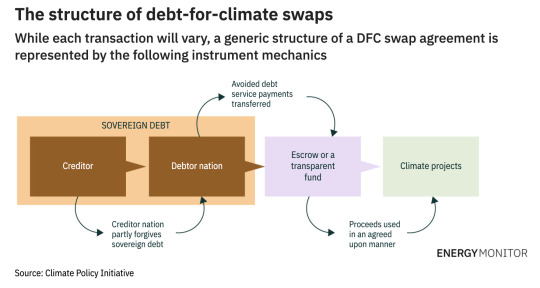
Debt-for-climate swaps free up fiscal resources so governments can improve resilience and transition to a low-carbon economy without causing a fiscal crisis or sacrificing spending on other development priorities. [These swaps] can create additional revenue for countries with valuable biodiversity or carbon sinks by allowing them to charge others to protect those assets, thereby providing a global public good.
Swaps can even result in an upgrade to a country’s sovereign credit rating, as was the case in Belize, which makes government borrowing cheaper [and improves the country's economy.]
Right now, these [swaps] are needed more than ever, with low-income countries dealing with multiple crises that have put huge pressure on public debt...
Debt-for-climate swaps: “Increasing in size and scale”
Although debt-for-climate swaps are not new, until recently the amount of finance raised globally from the instrument has been modest – just $1bn between 1987 and 2003, according to one OECD study. Just three of the 140 swaps over the past 35 years have had a value of more than $250m, according to the African Development Bank. The average size was a mere $26.6m.
However, the market has steadily picked up pace over the past two decades... In 2016, the government of the Seychelles signed a landmark agreement with developed nation creditor group the Paris Club, supported by NGO The Nature Conservancy (TNC), for a $22m investment in marine conservation.
The government of Belize followed suit in 2021 by issuing a $364m blue bond – a debt instrument to finance marine and ocean-focused sustainability projects – to buy back $550m of commercial debt to use for marine conservation and debt sustainability.
Then, last year, Barbados completed a $150m transaction, supported by the TNC and the Inter-American Development Bank, allowing the country to reduce its borrowing costs and use savings to finance marine conservation.
“Two or three years ago, we were talking about $50m deals,” says Widge. “Now they have gone to $250–300m, so they are definitely increasing in size and scale.”
Indeed, the success of the deals for the Seychelles, Belize and Barbados, along with the debt distress sweeping across the Global South, has sparked an uptick of interest in the model.
Ecuador is reported to be in negotiations with banks and a non-profit for an $800m deal, and Sri Lanka is discussing a $1bn transaction – which would be the biggest swap to date."
-via Energy Monitor, 2/1/23
Note: I'm leaving out my massive rant about how the vast majority of this debt is due to the damages of colonialism. And also countries being forced to "PAY BACK" COLONIZERS FOR THEIR OWN FREEDOM for decades or in some cases centuries (particularly infuriating example: Haiti). Debt-for-climate swaps are good news, and one way to help right this massive historic and ongoing economic wrong
#climate change#developing countries#economics#debt for climate#debt relief#cape verde#barbados#seychelles#ecuador#sri lanka#portugal#belize#global south#conservation#biodiversity#good news#hope#international politics
52 notes
·
View notes